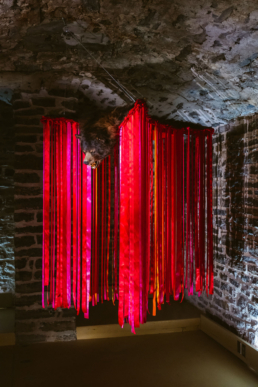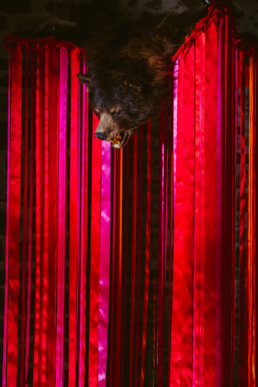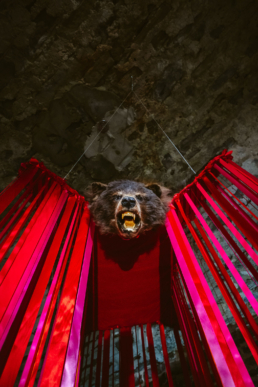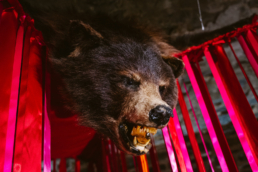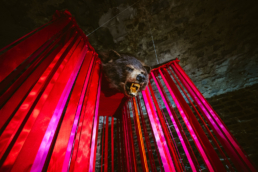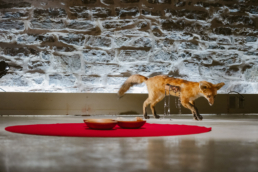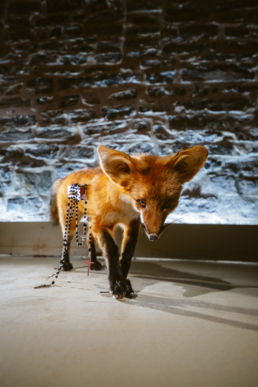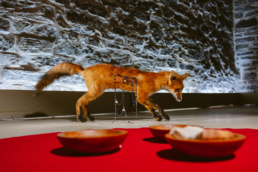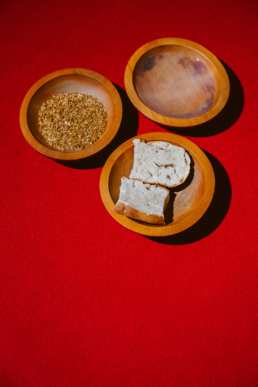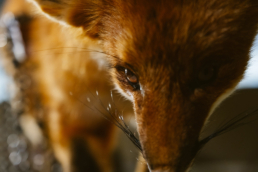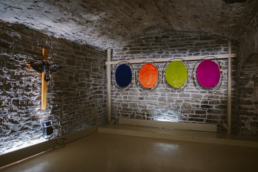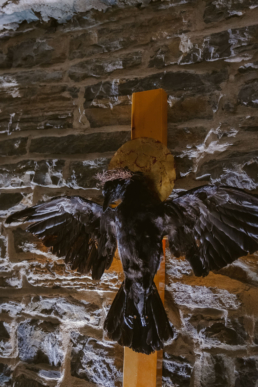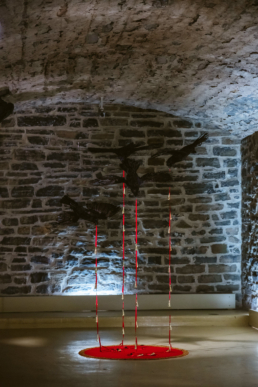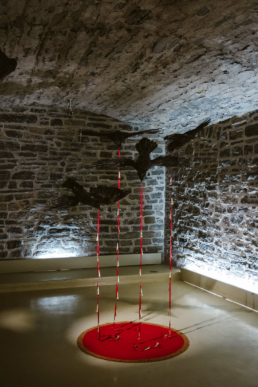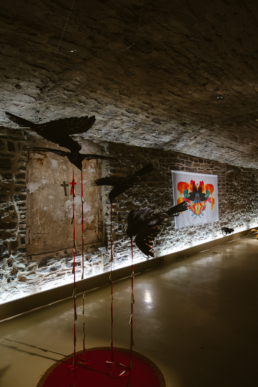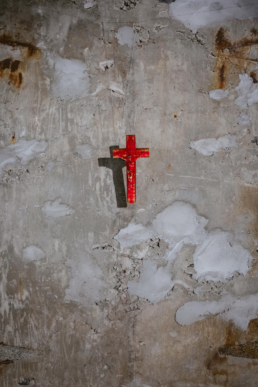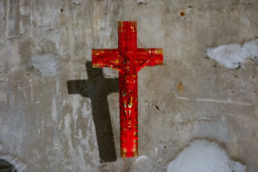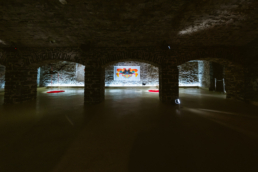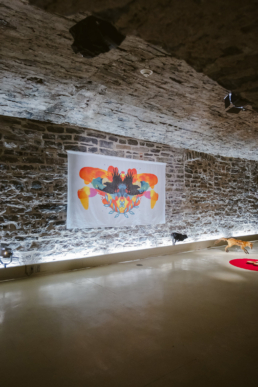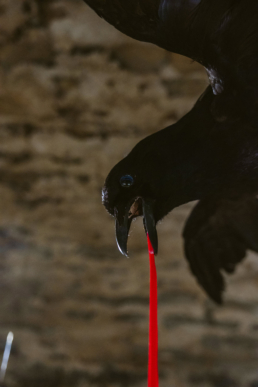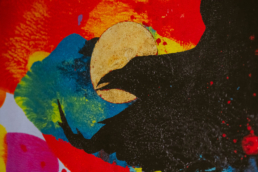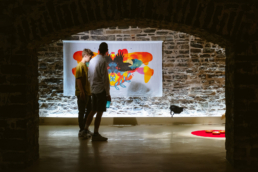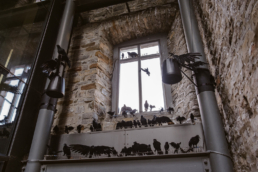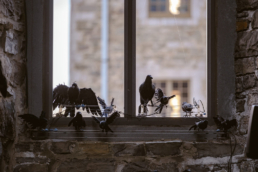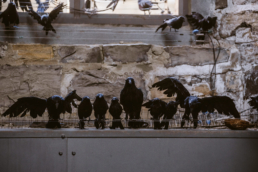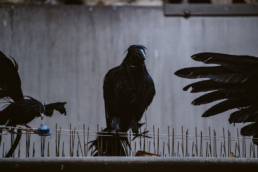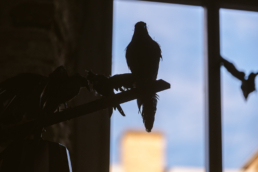June 22 – October 9, 2023
Eruoma Awashish: Kakike Ickote (Eternal Fire)
Curator : Michael Patten
Les Passages Insolites
Maison Hazeur, Québec, QC
Photo credits: Stéphane Bourgeois – Photographer
Eruoma Awashish’s exhibition Kakike Ickote (Eternal Fire) takes us on a journey into the intimate vaults of Maison Hazeur. The architectural features of low ceilings, stone walls, and arches enhance the sense of history and create an atmosphere of mystery and intrigue. Awashish’s work explores the complex relationship between First Nations spirituality, Christianity, and colonization. She is fascinated by the ways in which these different belief systems have intersected and influenced one another, and the impact of their interrelation on Indigenous peoples. Through her art, she seeks to challenge the dominant narratives of colonization and to highlight Indigenous peoples’ resilience and strength. She draws on traditional Indigenous art forms and motifs, as well as Christian iconography, to create works that speak to the complexity of this relationship.
Awashish holds a deep fascination with the sacred. Growing up in a community where the Catholic religion exerted a significant influence, she often wondered about her grandparents’ fervent devotion to the Catholic Church. Considering the Church’s troubling history, particularly its involvement in tragic events like residential schools, Awashish couldn’t help but question why her grandparents would faithfully recite their rosary and offer their prayers each night.
Reflecting on her observations, Awashish realized that, as a child, she witnessed her grandparents praying with their rosary in such a rapid manner that the words seemed to blend together. It was as if the actual words had become mere sounds, and yet, this did not diminish the depth of their connection to their creator. She came to understand that, for her grandparents and others like them, the act of connecting with their creators transcends the specific prayers or objects used. With the arrival of the Catholic Church and its priests in their community, they were told that their prayers needed to be done differently, but deep down, the essence of their connection with their creator remained unaltered. Understanding this fundamental truth has brought her a deeper appreciation for the resilience and spirituality of her community, no matter what external influences may have sought to alter the ways of her ancestors.
The artist’s objective is to portray the profound consequences of colonialism and the Catholic Church on her community. For example, she deliberately chose a catholic symbol, a cross, and then intricately wove it with red thread for her Untitled piece. This potent symbol serves as a representation of the ongoing efforts to heal the longstanding wounds of colonization. This act of repair parallels the act of stitching up physical wounds, highlighting the personal and collective healing journey that her work represents. It also evokes a larger theme of decolonizing symbols and returning to the essence of spirituality. The artist seeks to strip away the layers imposed by external influences and reconnect with the sacred at its core. By doing so, she aims to reclaim her people’s spirituality and heal the wounds caused by the intertwining legacies of colonialism and the Catholic Church.
Crows are another reoccurring element in her work. Awashish’s cousin told her about someone they knew who killed crows as target practice. The artist was shocked by this senseless killing and asked if she could take the crows for her art instead of them being discarded. With its crow on the cross, Messenger is a thought-provoking piece that speaks to the idea of honoring sacrifice and respecting all living beings, which is a central tenet of Indigenous traditions and worldviews. This message is especially crucial now, as we face unprecedented environmental and ecological challenges.
In Awashish’s artworks, crows are frequently depicted as messengers that can travel between the spiritual and earthly realms. In Pakoserimowin / Prayer, a murder of crows holding red satin ribbons adorned with jingle dress bells hover above a sacred circle of tobacco on the ground, serving as a powerful symbol of prayer. The jingle dress dance is much more than a visual spectacle; it represents a spiritual journey of healing. Tobacco plays a significant role in Indigenous culture, particularly among First Nations. It has been utilized for medicinal and ceremonial purposes for many generations. It is commonly offered as a form of prayer and a way to express gratitude to the spirits.
On her way to a friend’s camp, Awashish came across a fox on the side of the road that had been hit by a car. She was immediately drawn to its injured body, symbolizing the impact of trauma. In Tame Your Soul, Awashish placed a drawer full of rosaries in the wound of the fox, as if they were its entrails and viscera. To attract and tame the injured fox, she placed a bowl of water, food, and tobacco on the ground. The installation is a metaphorical representation of native people, wanting to connect and be seen, but hindered by the fear and wounds they carry. It reflects the challenging journey of decolonizing spirituality and taming one’s soul, and the need to create a welcoming and comfortable space for healing to occur. Awashish emphasizes the importance of respecting individuals and allowing them to heal and reconnect with their own identity and spirituality at their own pace.
The use of animal remains in art is often seen as a colonial practice that disregards the cultural significance of animals to Indigenous peoples. For many Indigenous communities, animals are sacred beings with spiritual significance, and the use of their remains in art can be seen as a violation of cultural beliefs. Additionally, when Indigenous artists use taxidermy in their art, there is a danger it can perpetuate stereotypes of Indigenous peoples as “primitive” or “savage,” further marginalizing Indigenous artists and their work. On the other hand, some Indigenous artists use taxidermy in their artwork to reclaim their cultural heritage and challenge colonial narratives. Incorporating taxidermy into their artwork is a way to connect with their ancestors and honor their cultural traditions, and to challenge the dominant Western art canon and assert their Indigenous identities.
Atamik / Inside features a repurposed bear rug that was on the verge of being discarded. Upon learning of its fate, the artist was driven to restore the bear’s dignity. Her intention was to elevate the bear beyond being seen as a mere rug or object, and instead, present it as a vibrant living mammal. To accomplish this, she adorned the bear with red ribbons, often associated with ceremonial attire. Through these ribbons, she aimed to infuse the bear with a profound sense of sacredness and symbolize the vital essence of life, as represented by the colour red.
One of the core values guiding Indigenous hunting practices is an understanding of the reciprocal relationship between humans and the natural world. Indigenous hunters often view themselves as caretakers of the land and animals and recognize the interdependence and harmony between all living beings. Hunting is seen not only as a means of sustenance but also as a responsibility to maintain the balance of ecosystems and preserve biodiversity. Additionally, Indigenous hunting practices emphasize respect, gratitude, and the sustainable use of resources. Hunters typically follow traditional protocols and rituals to honour the animals they hunt, expressing gratitude for the sacrifice and ensuring that the remains are utilized fully and respectfully.
Awashish had an opportunity to showcase her work in both the indoor and outdoor spaces of Maison Hazeur. Outside, a murder of crows has chosen the stairway as their clandestine meeting place, perching gracefully on surrounding beams and windows. Their presence recalls the intertwined relationships of nature and human civilization. It serves as a reminder that, amid the façade of human dominance, the natural world still holds its rightful place within the narrative of our surroundings. The crows’ discreet congregation also echoes the hidden depths and untold stories that lie within the walls of Maison Hazeur, waiting to be unearthed by curious explorers.


